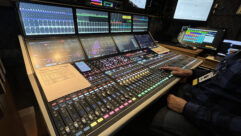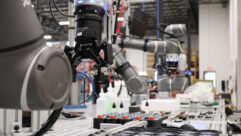SUGGESTIONS for the contractor’s library
Apr 1, 2000 12:00 PM,
Glen Ballou
The contractor’s library is a difficult thing to specify. Does it includeold books and new books? Does it include out-of-print books? Does itinclude books for sound system design and for recording and recordingstudios? Sales and marketing? No matter what I talk about in this column, Iam sure to miss someone’s favorite book or subject, so the following isonly a suggestion as to some of the many books we should have in ourlibrary. Only you know for sure where your interests lie and what subjectswill be most useful. There are many good books out there, and if we boughtevery one of them, we still would not always find that little tidbit ofinformation we seek. We will also have a substantial amount of overlap, butthis can end up being useful because we may not understand one author’sapproach to a given subject.
For the purpose of this column, let us first look at books about soundsystem design and installation. Many books have been written about thesubject in the last 50 years, but the book that certainly opened the eyesof many people going into audio is Sound System Engineering by Don andCarolyn Davis and published by Focal Press. This book was written from theauthor’s direct experience while operating Syn-Aud-Con. So many bookswritten by professors are mostly theoretical, but Sound System Engineeringis backed up with actual applications oriented tests and measurements.Although the book is not necessarily organized as I would have preferred,it is the first choice for my bookshelf.
Another fine book is Phil Giddings’ Audio System Design and Installation,published by Focal Press. This book includes 574 pages of practical,hands-on information and has become a standard reference in the industry.
As sound system designers, we need to know about acoustics andpsychoacoustics. A thorough understanding will help us discern what soundsgood, what sounds bad and why different types of music or voice requiredifferent types of installations. Acoustics and Psychoacoustics by DavidHoward and James Angus from Focal Press is an excellent source formastering this subject. Also, for a bit more cerebral treatment oncognition and perception, you might want to aquire The Psychology of Music,edited by Diana Deutsch and published by Academic Press, which focuses onmusic perception and gives insight into how the brain groups musicalinformation.
We need to know much about acoustics, and author F. Alton Everest haswritten much about the subject. His book, The Master Handbook of Acoustics,(third edition), published by TAB Electronics, is a compendium of subjectsincluding basics and acoustics for studios, home listening rooms andrecording studios, to name a few. This could be useful for home listeningrooms and home theaters, which is a market that is sure to grow by leapsand bounds.
Not to be forgotten in this list of books on acoustics are Leo Beranek’sseminal texts Acoustics and Music, Acoustics & Architecture, originallypublished by McGraw-Hill and John Wiley & Sons, respectively. They areavailable through the Acoustical Society of America as published by theAmerican Institute of Physics. You cannot mention Beranek’s name withoutalso mentioning Harry F. Olson, whose Elements of Acoustical Engineeringhas long been considered the bible of electroacoustics and was firstpublished in 1940. Luckily, back in 1991, the publisher Professional AudioJournals resurrected the title Acoustical Engineering, which is essentiallya third edition of the original work, as outlined in the introduction ofthe 1991 edition written by Jesse Klapholz.
M. David Egan’s large-format book Architectural Acoustics published byMcGraw Hill (second edition, 1988) is another important work on our shelf,and is a must for all libraries.
Another new book on acoustics is Architecture, Engineering and theEnvironment by Charles Salter and Associates and published by William StoutPublishing. This book was written by 28 employees of the company andincludes sketches and architectural drawings. The book also has 32 casestudies. Consult Mark Gander’s review of Architecture, Engineering and theEnvironment in the December 1999 issue of S&VC for some more details on thepublication.
The Audio System Designer Technical Reference by Peter Mapp is a valuablereference that contains charts, tables, graphs and data useful in thedesign of sound systems. This sturdy little loose-leaf bound reference canbe obtained from the Syn-Aud-Con folks via its web-site or by placing acall.
Although not the most exciting book, one that sound system installers needto have is NEC 1999 National Electrical Code Vol. 70. It is written by theNational Electrical Code Committee and published by the National FireProtection Association. Remember, we are responsible for following thecode. If we do not, we get sued or possibly jailed. Another book to haveaccess to and is an essential part of my library is the Journeyman’s Guideto the National Electrical Code, 1999 edition, first edition, by F. MarcoGotshaw and published by Prentice Hall. It explains the code in layman’sterms and includes general mathematical operations and common electricalformulas.
In the business management department, I recommend The Entrepreneur’sHandbook, Lessons from the Battlefield by Alan Kruglak, published by ARKSolutions. This is a non-technical book about running a company, making itprofitable and treating your employees the way you would want to betreated, an important book for all of us. Alan now has three booksavailable, the most recent, The Battle for Higher Gross Margins, he wrotewith his brother Glen. Keep an eye out for a review of this one in a futureissue.
Although I hesitate to recommend my own book, The Handbook For SoundEngineers, the New Audio Cyclopedia published by Focal Press is a powerfulreference book because of the 16 authors that wrote the 37 chapters. Suchauthors as F. Alton Everest, Don Davis, Ken Pohlmann, David Miles Huber andDr. Gene Patronis and an interesting chapter by Chip Davis on the recordingsetup of some popular CDs make this book a wealth of information.
There are books that are useful for sound system design and for recordingand recording studios. Certainly, we need as much information as we can geton mics and loudspeakers because this is where the magic happens whenacoustic energy is changed into electrical energy and vice versa. Whatdevices we use and how we use them is of utmost importance.
One of the many good books on mics is Stereo Microphone Techniques by BruceBartlett and published by Focal Press. This book explains correct micpositioning for various recording applications. Many of these mics and mictechniques are portrayed in recording studio applications in the book, butthe same principles can be applied for use in sound reinforcement. Have younoticed yet that Focal Press seems to publish many of the books I haverecommended? One of the reasons for this phenomenon is that a few yearsago, Howard W. Sams sold off many of its audio books to Focal Press.
There are many good books written on loudspeakers, but one of the thesebooks, which is the uncut lectures given by Benson in the 1960s and 1970sand printed in 1993, is the classic on loudspeaker design. The Theory andDesign of Loudspeaker Enclosures by J. E. Benson was made possible throughthe efforts of Don and Carolyn Davis and can be purchased from Syn-Aud-Conor Mix magazine. Benson explains damped-reflex, passive radiator reflex,acoustic-resistance controlled, closed-box and infinite-baffle loudspeakers.
Another good book on loudspeakers is Loudspeaker and Headphone Handbook,second edition, edited by John Borwick and published by Focal Press.Written by a dozen specialists, the book is a valuable reference book forthe sound system designer. The book includes digital signal processing,loudspeaker enclosures and computer-assisted design and testing.
Although not directly related to contracting, we still need books onrecording and recording studios not only because at times we are stillcalled on to provide these services, but also because many of theprinciples directly cross over into the sound reinforcement area. First tocome to mind is a new book by Bruce and Jenny Bartlett called On LocationRecording Techniques, published by Focal Press. The book covers classicaland popular music recording in clubs, auditoriums and concert halls,including how to use some of the new compact mixers and digitalmultitracks. Another book by the same authors is Practical RecordingTechniques, second edition, which is a step-by-step approach to audiorecording for the not-quite professional recording engineer. I know thatfor me, this book makes it much easier to understand this complicatedsubject.
Of course we cannot leave F. Alton Everest out of this field. Sound StudioConstruction on a Budget, published by TAB Electronics, gives 10easy-to-follow plans for building various inexpensive studios that might bequite adequate for your needs. The book includes wall, ceiling and floorconstruction, HVAC precautions, doors and windows, site selection and soundabsorption coefficients.
Another new book is 5.1 Channel Surround Sound Up and Running by TomlinsonHolman published by Focal Press. Mr. Holman was instrumental in thedevelopment of the THX sound system, Home THX and THX Digital Mastering.The book has a wealth of information about the 5.1 channel surround systemand what changes will be required by studios and monitoring rooms to makethem compatible with the specification as well as mixing tips anddistribution formats.
MIDI is an important part of recording, and The MIDI Manual, second editionby David Miles Huber and published by Focal Press is probably the mostauthoritative book on the subject. David includes new developments (1998)in MIDI hardware and software along with tips and examples on sequencingand mixing techniques.
Digital audio is the most important development in our industry as we enterthe new millennium. Principles of Digital Audio by Ken C. Pohlmann is mybook of choice on that subject. Ken discusses DAT, CD formats,workstations, optical disc recording, interfacing, coding theory anddigital audio broadcasting.
One of the horrible things that happens as we get older is our inability toremember all of the things we could remember in our youth. When thathappens, we can rely on references for the math, physics and acoustics toremember for us. To save space, I will simply recommend the books withoutany comments:
– Handbook of Electronic Tables and Formulas, sixth edition, by the HowardW. Sams Engineering Staff, published by Prentice Hall.
– Electronics Pocket Handbook, third edition, by Daniel L. Metzger,published by Prentice Hall.
– Electronics Pocket Reference, third edition, by Edward Pasahow, publishedby McGraw-Hill.
– An Introduction to Mathematics and Engineering Science, by SidneyBertram, Syn-Aud-Con.
– Dictionary of Music Terms and Cords, by Albert DeVito, Mix magazine.
– McGraw-Hill Electronics Dictionary, sixth edition, by Neil Sclater andJohn Markus, published by McGraw-Hill.
– Sound Engineers’s Pocket Book, by Michael Talbot-Smith, Published byFocal Press.
We all need to be sociable when talking to a customer, an architect or astranger. I want to leave you with one final book that I reviewed for S&VCa while back. It is entertaining to read and will give you someentertaining tidbits of useless information that might break the ice foryou. Did Monkeys Invent the Monkey Wrench by Vince Staten and published bySimon & Schuster will tell you how WD40 and the crapper got their names andwhy batteries are not called voltas after the man who created the firstbattery.
As you can see, we hardly scratched the surface in our list of books weshould have in our library as contractors. To start, we have not even begunto cover the video side of the business. Stay tuned for a future columncovering that area, and for further information, visit the websitemaintained by Syn-Aud-Con at www.synaudcon.com. If you have trouble findingany of these titles in your local book store, you might consider trying tofind them on www.bookfinder.com, which is a powerful search engine coveringmany different sources for new and used books. Opamp Technical Books, LosAngeles, is another great resource, and their website is www.opamp.com.Also, visit the site,http://wssh.net/-wattsup/Audio%20related%20Site%20list.html, which ismaintained by Steve Ekblad and is updated almost daily with so manydifferent links that it is a real resource for many different audio-relatedInternet sites. Take a look.








